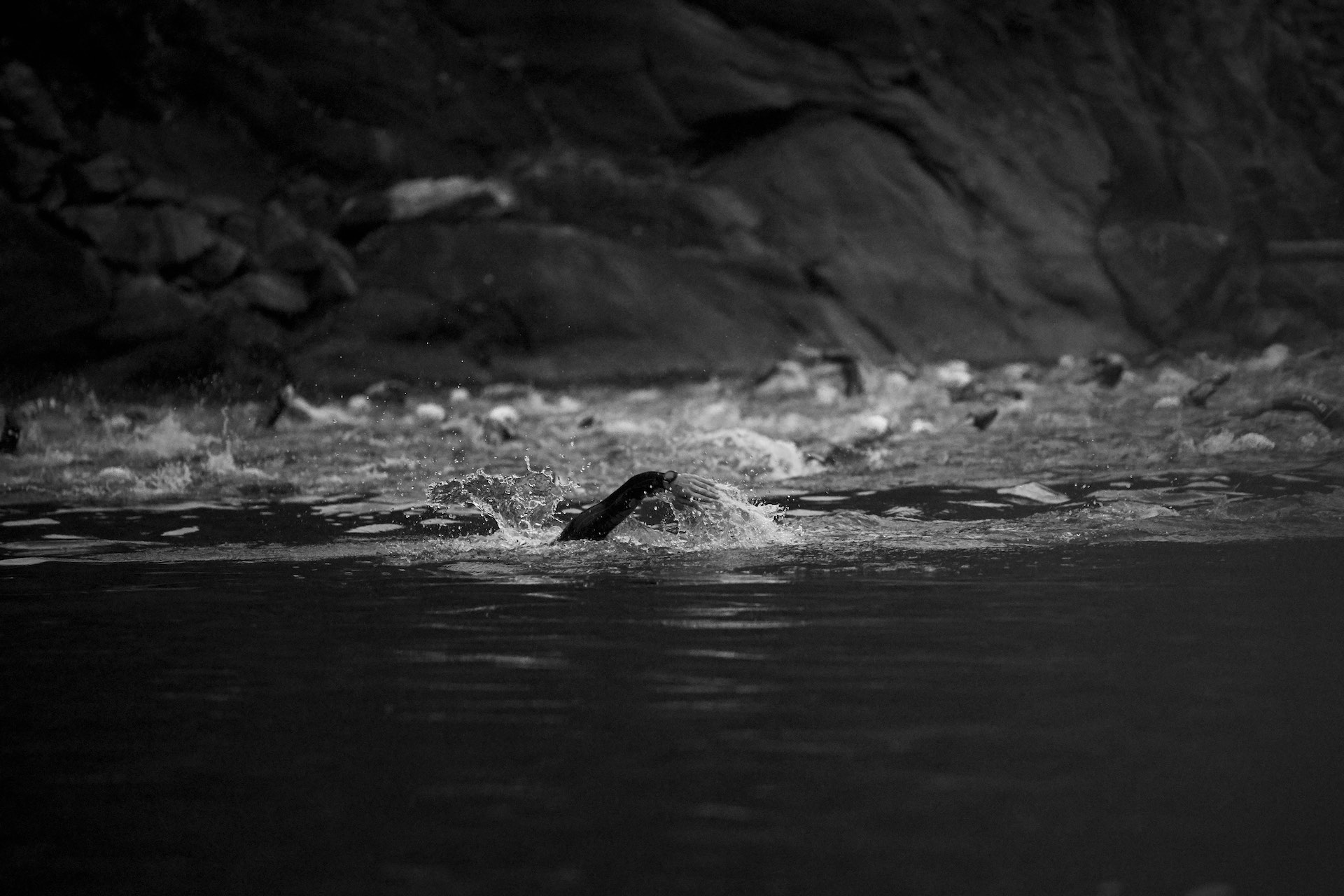
Published: 24.Apr.2019
Swimming in cold water – Part 3
The Norseman swim is legendary. Everybody has heard about the jump from the ferry into the dark, deep fjord, surrounded by hovering, snow clad mountains in the most serenely beautiful of landscapes. If only it wasn’t for the cold water.
By Jonny Hisdal, PhD, professor of physiology, and a 13 time Norseman finisher, and Jørgen Melau, PhD candidate in Cold Water Swimming and Norseman’s Safety Director.
Acclimatization
The human body is highly adaptable to different circumstances, and the good news is that just as we can acclimatize to altitude, we can acclimatize to cold. A number of scientific studies, conducted e.g. among Inuit and among arctic fishermen, have shown that people who live and work in cold surroundings tolerate cold better.
To prepare for the Norseman swim and become accustomed to your body’s response to the cold, you should therefore practice swimming in cold waters under safe circumstances. Such acclimatization could considerably reduce your cold shock. In the beginning, limit your exposure to cold water to short periods in shallow waters. Gradually increase duration to longer swims close to the shore and escorted by a boat. Do not postpone your first cold water exposure to that chilly August dawn when you jump from the ferry into the Eidfjord.
Protect yourself
When you swim cold waters – at Norseman or elsewhere – a good wetsuit is a must. A good wetsuit is a suit that fits the wearer’s body and insulates well. And by the way: an expensive suit does not necessarily equal the best insulation. A good suit will provide insulation by holding on to water that is heated by your body. Having the right size wetsuit is vital. If it is too large or is punctured from wear, the water held inside the suit will constantly change, and your body will constantly be heating new quantities of water. When you swim cold waters in an ill-fitting suit, your body heat will therefore gradually be depleted, increasing your risk of hypothermia.
Norseman permits neoprene socks and full hoods. Because the blood stream to the feet is limited, socks will not make that much of a difference. But even in cold surroundings, the bloodstream to your head is considerable, and a good neoprene hood that covers your neck and head can provide efficient protection. The carotid arteries are located very close to the skin, and exposure of the carotid arteries to cold water is a major source of heat loss. A full neoprene hood of the type usually used by divers, also covers the neck, and provides very good protection of the carotid arteries. Additionally, wearing ear plugs can prevent cold water from entering your ears, thus abating the risk of acute dizziness described in our past article.
Pour water into your wetsuit before jumping in
As mentioned, water is vital to wetsuit insulation. Pouring the contents of a small water bottle into your suit before jumping in, will reduce the inevitable cold shock. Our skin holds dedicated temperature receptors, which are very sensitive to temperature changes. If your skin is warm when you jump in, these receptors will release more forceful signals, which, in return, will reinforce the cold shock. Pouring water into your suit just before you jump into the fjord will provide your body with a signal that helps it adapt to the appropriate temperature.
Head above water
Keeping your head above water as much as possible as you swim towards the starting line will allow your body to adapt more gradually to the water temperature. As you may remember from our past article, cold water on your face triggers diver’s reflex, which slows your heart rate and lowers blood pressure, while the cold also can induce cold shock, which causes your heart to beat faster and increases blood pressure. These mixed signals may increase the risk of arrhythmia, which, in a person with an undiagnosed heart disease, can be dangerous.
By keeping your head above water, making only a few swim strokes with your face under water before start, you can reduce both diver’s reflex and cold shock. You are also less likely to be stressed by hyperventilation, which to varying degree will be your body’s response to contact with the cold water.
Starting field position
As swimmers get ready for the ferry to hoot its horn to signal the start, the water is teeming with activity. Stress levels (and tempers) can be high, as swimmers maneuver to find a favorable starting position, or a good swimmer to draft. Please use your good sense when placing yourself in the starting field. If swimming is not your strong suit, place yourself in the back or on the wings of the field. You will have ample opportunity later on, if you find yourself able to advance. If you are a breast swimmer, we suggest that you place yourself in the back of the field at the starting line, to avoid kicking another athlete in the face during the first chaotic minutes. In the beginning, most athletes will swim at a faster pace than they are able to sustain for the whole leg anyway, so even if you place yourself in the back of the field, you are likely to find the starting pace fast enough.
Please show consideration for your fellow athletes – especially during this phase. The fjord is big and there is no need to attempt swimming on top of somebody else, even if they are going too slow for your taste. In this early phase, with hyperventilation and reduced capacity to hold your breath, being pushed underwater can be dangerous. Also, should you lose your goggles early on you can ruin the race for which you have trained for so long. So please watch out, start out conservatively, and show consideration to those around you.
Increase intensity gradually
Getting an efficient warm-up session in cold water is tricky, as you want to avoid lengthy exposure to the cold before start. Take this into account early on in your swim, setting out calmly and increasing intensity as your body warms up.
Studies of sudden fatalities in triathlons – including triathlons where the swim leg was cancelled – show fatalities as happening most frequently in the first leg of the event. This may be due to an abrupt start at high intensity without a proper warm-up.
During marathons sudden fatalities tend to occur towards the end of the race. One of the explanations is that many marathoners will make a dash for the finish, heightening intensity to a level that increases the risk of cardiac arrest.
Take symptoms seriously
If you feel dizzy or unwell, please take these symptoms seriously. At Isklar Norseman, the swimming field will be monitored by people in kayaks and medical crew in boats at all times. Please make sure you attract their attention if you have problems, or if you see other swimmers behaving erratically. Be responsible, stop and check if someone looks like he or she needs help. Your simple consideration may save a life. And remember – a drowning victim might now call for help by themself.
Self-testing
The issue of heart screening of athletes has been ongoing for years. Soccer has introduced mandatory medical testing before licensing athletes to play in the upper league. While some countries have similar testing in other sports, it is usually not a requirement. As screening everybody would involve high costs and a number of other issues, it has so far been deemed unnecessary. However, numerous attempts have been made to develop simple tests that you can take on your own. These tests can help you find out if you may be at risk and should consider seeing a cardiologist for a thorough examination before embarking on an extreme endurance event like a marathon or a triathlon. For one example of such a test, see Mats Børjesson et al. in Eur J Cardiovasc Prev Rehabil. 2011 Jun;18(3):446-58.
Next article
We had so much to say about the subject of safe swimming that we are planning a bonus article. The fourth article in this series of three (!) will tell you more about how you can train open water swimming as safely as possible.

